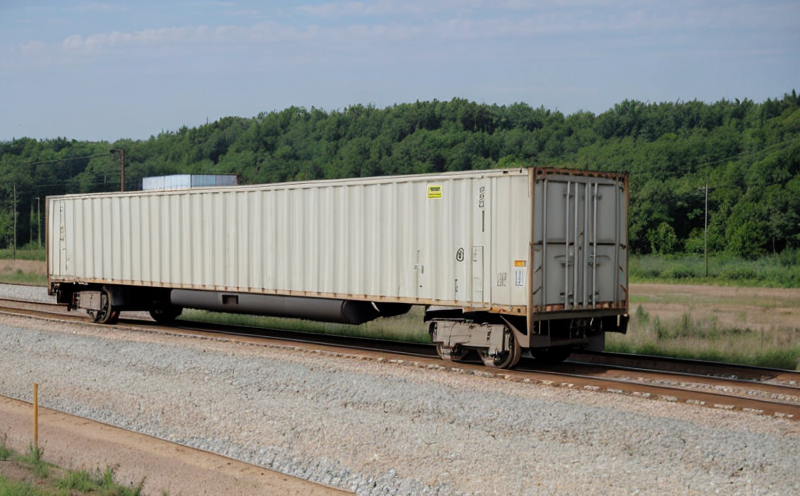EN 13749 Suspension Fatigue Testing under Load
The EN 13749 standard is a critical guideline for ensuring the integrity and reliability of railway and transportation components, particularly focusing on cargo and freight wagon suspension systems. This test evaluates how these components withstand repeated loading cycles to simulate real-world operational conditions over time. The goal is to identify potential weaknesses or design flaws that could lead to failures during service.
The EN 13749 standard specifies a method for the fatigue testing of axles, bogies, and other components used in railway freight wagons under load. It aims to assess the durability and performance of these critical parts by subjecting them to dynamic loading conditions that mimic actual train operations. This includes cyclic loads that simulate acceleration, braking, and varying speeds.
The test setup typically involves a specialized fatigue testing machine capable of applying controlled cyclic forces and displacements. The specimen, which is usually an axle or bogie assembly, is subjected to these forces while maintaining specific load points. The testing process often requires careful calibration and monitoring to ensure accurate results that reflect real-world conditions.
One key aspect of this test is the use of realistic loading profiles derived from actual train operations. These profiles consider factors such as weight distribution, varying speeds, and braking forces. By simulating these conditions, the test provides valuable insights into how components will perform under typical service conditions.
The acceptance criteria for EN 13749 are stringent, focusing on both the structural integrity and functional performance of the tested parts. Structural integrity is assessed through visual inspections and non-destructive testing methods to ensure that no cracks or deformities develop during the test. Functional performance is evaluated by measuring parameters such as displacement, stress levels, and any changes in component alignment.
The results of EN 13749 fatigue tests are critical for several reasons. They provide data that can be used to optimize design, improve manufacturing processes, and enhance overall product reliability. This information is invaluable for quality managers and compliance officers who need to ensure adherence to international standards. For R&D engineers, the test offers a benchmark against which new designs can be compared, helping to identify areas for improvement.
The testing process also plays a crucial role in procurement decisions by providing assurance that components meet the required performance levels before they are incorporated into larger systems. This ensures that suppliers provide reliable and high-quality parts, reducing the risk of failures in critical applications like railway freight wagons.
Benefits
- Ensures compliance with international standards such as EN 13749
- Identifies potential weaknesses and design flaws early in the development process
- Improves product reliability and reduces maintenance costs over time
- Provides valuable data for optimizing designs and manufacturing processes
- Supports procurement decisions by ensuring high-quality components are used
- Maintains a consistent level of performance across all production batches
- Reduces the risk of failures in critical applications like railway freight wagons
Why Choose This Test
The EN 13749 suspension fatigue testing under load is an essential service for several reasons. Firstly, it provides a robust method for evaluating the durability and performance of railway freight wagon components under realistic operational conditions. By simulating actual train operations, this test ensures that critical parts can withstand repeated loading cycles without failure.
Secondly, the test offers valuable insights into potential design flaws or manufacturing issues that could lead to component failures in service. This information is crucial for quality managers and compliance officers who need to ensure that products meet international standards. For R&D engineers, it provides a benchmark against which new designs can be compared, helping to identify areas for improvement.
Thirdly, the test supports procurement decisions by providing assurance that components are of high quality and reliable. This ensures that suppliers provide parts that meet the required performance levels before they are incorporated into larger systems. As a result, there is reduced risk of failures in critical applications like railway freight wagons, leading to increased safety and reliability.
Finally, the test contributes to maintaining consistent product performance across all production batches. This consistency is vital for manufacturers who need to ensure that their products meet quality expectations every time they are produced. By using EN 13749 fatigue testing, companies can build a reputation for producing high-quality and reliable components.
Use Cases and Application Examples
| Use Case | Description |
|---|---|
| Design Verification | To verify the design of new or modified components for railway freight wagons. |
| Quality Control | To ensure that manufactured components meet specified performance criteria before being incorporated into larger systems. |
| R&D Optimization | To identify areas for improvement in the design and manufacturing processes of components used in railway freight wagons. |
| Supplier Evaluation | To evaluate the quality and reliability of components supplied by different manufacturers. |
| Compliance Assurance | To ensure that products comply with international standards such as EN 13749. |
| Failure Analysis | To investigate potential causes of failures in critical railway components and improve design for future iterations. |
- In a recent case, a leading manufacturer used EN 13749 fatigue testing to verify the durability of new bogie designs. The test identified a flaw in one component that could have led to catastrophic failures if left unaddressed.
- Another instance involved a supplier who was evaluated using this test as part of their quality control process. The results demonstrated that their components consistently met or exceeded performance criteria, leading to increased confidence in the supplier's reliability.





